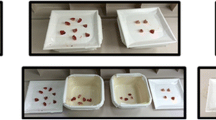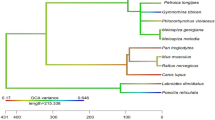Abstract
In comparative psychology, both similarities and differences among species are studied to better understand the evolution of their behavior. To do so, we first test species in tasks using similar procedures, but if differences are found, it is important to determine their underlying cause(s) (e.g., are they due to ecology, cognitive ability, an artifact of the study, and/or some other factor?). In our previous work, primates performed unexpectedly poorly on an apparently simple two-choice discrimination task based on the natural behavior of cleaner fish, while the fish did quite well. In this task, if the subjects first chose one of the options (ephemeral) they received both food items, but if they chose the other (permanent) option first, the ephemeral option disappeared. Here, we test several proposed explanations for primates’ relatively poorer performance. In Study 1, we used a computerized paradigm that differed from the previous test by removing interaction with human experimenters, which may be distracting, and providing a more standardized testing environment. In Study 2, we adapted the computerized paradigm from Study 1 to be more relevant to primate ecology. Monkeys’ overall performance in these adapted tasks matched the performance of the fish in the original study, showing that with the appropriate modifications they can solve the task. We discuss these results in light of comparative research, which requires balancing procedural similarity with considerations of how the details of the task or the context may influence how different species perceive and solve tasks differently.


Similar content being viewed by others
References
Anderson JR, Degiorgio C, Lamarque C, Fagot J (1996) A multi-task assessment of hand lateralization in capuchin monkeys (Cebus apella). Primates 37:97–103
Barros RDS, Galvão ODF, Mcilvane WJ (2002) Generalized identity matching-to-sample in Cebus apella. Psychol Rec 52:441–460
Beran MJ (2007) Rhesus monkeys (Macaca mulatta) enumerate sequentially presented sets of items using analog numerical representations. J Exp Psychol Anim B 33:42–54
Beran MJ (2008) Monkeys (Macaca mulatta and Cebus apella) track, enumerate, and compare multiple sets of moving items. J Exp Psychol Anim B 34:63–74
Beran MJ, Parrish AE (2012) Sequential responding and planning in capuchin monkeys (Cebus apella). Anim Cogn 15:1085–1094
Beran MJ, Smith JD (2011) Information seeking by rhesus monkeys (Macaca mulatta) and capuchin monkeys (Cebus apella). Cognition 120:90–105
Beran MJ, Harris EH, Evans TA, Klein ED, Chan B, Flemming TM, Washburn DA (2008a) Ordinal judgments of symbolic stimuli by capuchin monkeys (Cebus apella) and rhesus monkeys (Macaca mulatta): the effects of differential and nondifferential reward. J Comp Psychol 122:52–61
Beran MJ, Klein ED, Evans TA, Chan B, Flemming TM, Harris EH, Washburn DA, Rumbaugh DM (2008b) Discrimination reversal learning in capuchin monkeys (Cebus apella). Psychol Rec 58:3–14
Beran MJ, Smith JD, Coutinho MVC, Couchman JJ, Boomer J (2009) The psychological organization of “uncertainty” responses and “middle” responses: a dissociation in capuchin monkeys (Cebus apella). J Exp Psychol Anim B 35:371–381
Beran MJ, Evans TA, Klein ED, Einstein GO (2012) Rhesus monkeys (Macaca mulatta) and capuchin monkeys (Cebus apella) remember future responses in a computerized task. J Exp Psychol Anim B 38:233–243
Beran MJ, Perdue BM, Smith JD (2014) What are my chances? Closing the gap in uncertainty monitoring between rhesus monkeys (Macaca mulatta) and capuchin monkeys (Cebus apella). J Exp Psychol Anim Learn Cogn 40:303–316
Bitterman ME (1960) Toward a comparative psychology of learning. Am Psychol 15:704–712
Bitterman ME (1965) Phyletic differences in learning. Am Psychol 20:396–410
Blanchard TC, Wilke A, Hayden BY (2014) Hot-hand bias in rhesus monkeys. J Exp Psychol Anim Learn Cogn 40:280–286
Boesch C, Boesch H (1989) Hunting behavior of wild chimpanzees in the Taï National Park. Am J Phys Anthropol 78:547–573
Boysen ST, Berntson GG (1995) Responses to quantity: perceptual versus cognitive mechanisms in chimpanzees (Pan troglodytes). J Exp Psychol Anim B 21:82–86
Boysen ST, Berntson GG, Hannan MB, Cacioppa JT (1996) Quantity-based interference and symbolic representations in chimpanzees (Pan troglodytes). J Exp Psychol Anim B 22:76–86
Boysen ST, Mukobi KL, Berntson GG (1999) Overcoming response bias using symbolic representations of number by chimpanzees (Pan troglodytes). Anim Learn Behav 27:229–235
Boysen ST, Berntson GG, Mukobi KL (2001) Size matters: impact of size and quantity on array choice by chimpanzees (Pan troglodytes). J Comp Psychol 115:106–110
Brosnan SF (2010) What do capuchin monkeys tell us about cooperation? In: Forsyt DR, Hoyt CL (eds) For the greater good of all: perspectives on individualism, society, and leadership. Palgrave Macmillan, Basingstoke, pp 11–28
Brosnan SF, de Waal FBM (2004) Socially learned preferences for differentially rewarded tokens in the brown capuchin monkey (Cebus apella). J Comp Psychol 118:133–139
Brosnan SF, Wilson B, Beran MJ (2012) Old World monkeys are more similar to humans than New World monkeys when playing a coordination game. Proc R Soc Lond B Biol Sci 279:1522–1530
Bshary R (2001) The cleaner fish market. In: Noë R, van Hooff JARAM, Hammerstein P (eds) Economics in nature. Cambridge University Press, Cambridge, pp 146–172
Bshary R, Grutter AS (2002) Asymmetric cheating opportunities and partner control in the cleaner fish mutualism. Anim Behav 63:547–555
Bshary R, Schäffer D (2002) Choosy reef fish select cleaner fish that provide high-quality service. Anim Behav 63:557–564
Chalmeau R, Lardeux K, Brandibas P, Gallo A (1997) Cooperative problem solving by orangutans (Pongo pygmaeus). Int J Primatol 18:23–32
Cohen J (1988) Statistical power analysis for the behavioral sciences, 2nd edn. Erlbaum, Hillsdale
Davison M, Baum WM (2000) Choice in a variable environment: every reinforce counts. J Exper Anal Behav 74:1–24
de Waal FBM, Leimgruber K, Greenberg AR (2008) Giving is self-rewarding for monkeys. Proc Natl Acad Sci USA 105:13685–13689
Dufour V, Pelé M, Neumann M, Thierry B, Call J (2009) Calculated reciprocity after all: computation behind token transfers in orangutans. Biol Lett 5:172–175
Evans TA, Beran MJ (2012) Monkeys exhibit prospective memory in a computerized task. Cognition 125:131–140
Evans TA, Beran MJ, Chan B, Klein ED, Menzel CR (2008) An efficient computerized testing method for the capuchin monkey (Cebus apella): adaptation of the LRC-CTS to a socially housed nonhuman primate species. Behav Res Methods 40:590–596
Fragaszy DM, Visalberghi E, Fedigan LM (2004) The complete capuchin: the biology of the Genus Cebus. Cambridge University Press, Cambridge
Galdikas BMF (1988) Orang-utan diet, range, and activity at Tanjung Puting, Central Borneo. Int J Primatol 9:1–35
Girndt A, Meier T, Call J (2008) Task constraints mask great apes’ ability to solve the trap table task. J Exp Psychol Anim B 34:54–62
Goodall J (1986) The chimpanzees of Gombe: patterns of behavior. Harvard University Press, Cambridge
Gossette RL, Inman N (1966) Comparison of spatial successive discrimination reversal performances of two groups of New World monkeys. Percept Motor Skill 23:169–170
Grant DA (1946) New statistical criteria for learning and problem solution in experiments involving repeated trials. Psychol Bull 43:272–282
Harlow HF (1949) The formation of learning sets. Psychol Rev 56:51–65
Harlow HF, Warren JM (1952) Formation and transfer of discrimination learning sets. J Comp Physiol Psychol 45:482–489
Kamil AC (1988) Synthetic approach to the study of animal intelligence. In: Leger DW (ed) Comparative perspectives in modern psychology: Nebraska symposium on motivation. University of Nebraska Press, Lincoln, pp 230–257
Kamil AC (1998) On the proper definition of cognitive ethology. In: Balda RP, Bednekoff PA, Kamil AC (eds) Animal cognition in nature. Academic Press, New York
Masataka N (1990) Handedness of capuchin monkeys. Folia Primatol 55:189–192
Mulcahy NJ, Call J (2006) How great apes perform on a modified trap-tube task. Anim Cogn 9:193–199
Murray EA, Kralik JD, Wise SP (2005) Learning to inhibit prepotent responses: successful performance by rhesus macaques, Macaca mulatta, on the reversed-contingency task. Anim Behav 69:991–998
Pepperberg IM, Hartsfield LA (2014) Can Grey parrots (Psittacus erithacus) succeed on a “complex” foraging task failed by nonhuman primates (Pan troglodytes, Pongo abelii, Sapajus apella) but solved by wrasse fish (Labroides dimidiatus)? J Comp Psychol 128:298–306
Richardson WK, Washburn DA, Hopkins WD, Savage-Rumbaugh ES, Rumbaugh DM (1990) The NASA/LRC computerized test system. Behav Res Methods Instrum Comput 22:127–131
Rijksen HD (1978) A field study on Sumatran orangutans (Pongo pygmaeus abelii Lesson 1827): ecology, behaviour and conservation. H. Veenman Zonen BV, Wageningen
Rosenthal R (1991) Meta-analytic procedures for social research, 2nd edn. Sage, Newbury Park, p 19
Rumbaugh DM (1971) Evidence of qualitative differences in learning processes among primates. J Comp Physiol Psychol 76:250–255
Rumbaugh DM (1997) Competence, cortex, and primate models: a comparative primate perspective. In: Krasnegor NA, Lyon GR, Goldman-Rakic PS (eds) Development of the prefrontal cortex: evolution, neurobiology, and behavior. Paul H. Brookes, Baltimore, pp 117–139
Salwiczek LH, Prétôt L, Demarta L, Proctor D, Essler J, Pinto AI, Wismer S, Stoinski T, Brosnan SF, Bshary R (2012) Adult cleaner wrasse outperform capuchin monkeys, chimpanzees and orang-utans in a complex foraging task derived from cleaner-client reef fish cooperation. PLoS ONE 7:e49068
Saverino C, Gerlai R (2008) The social zebrafish: behavioral responses to conspecific, heterospecific, and computer animated fish. Behav Brain Res 191:77–87
Schrier AM (1984) Learning how to learn: the significance and current status of learning-set formation. Primates 25:95–102
Siebeck UE, Litherland L, Wallis GM (2009) Shape learning and discrimination in reef fish. J Exp Biol 212:2112–2118
Siebeck UE, Parker AN, Sprenger D, Mäthger LM, Wallis G (2010) A species of reef fish that uses ultraviolet patterns for covert face recognition. Curr Biol 20:407–410
Timberlake W, Gawley DJ, Lucas GA (1987) Time horizons in rats foraging for food in temporally separated patches. J Exper Anim Behav Proc 13:302–309
Washburn DA, Rumbaugh DM (1992) Testing primates with joystick-based automated apparatus: lessons from the Language Research Center’s Computerized Test System. Behav Res Methods Instrum Comput 24:157–164
Westergaard GC, Suomi SJ (1997) Capuchin monkey (Cebus apella) grips for the use of stone tools. Am J Phys Anthropol 103:131–135
Acknowledgments
We thank Michael J. Beran for helping with computer programming.
Funding
L.P. was funded by the Swiss Science Foundation (Doc.Mobility) and the Second Century Initiative in Primate Social Cognition, Evolution & Behavior (2CI-PSCEB) at Georgia State University. R.B. was funded by the Swiss Science Foundation. S.F.B. was funded by National Science Foundation Grants SES 1123897 and SES 1425216.
Author information
Authors and Affiliations
Corresponding author
Ethics declarations
Conflict of interest
The authors declare that they have no conflict of interest.
Ethical approval
All applicable international, national, and/or institutional guidelines for the care and use of animals in this study were followed. All procedures performed in this study were in accordance with the Georgia State University Institutional and Animal Care and Use Committee (capuchins: A13022, rhesus: A13021) and met the standards of the USA.
Rights and permissions
About this article
Cite this article
Prétôt, L., Bshary, R. & Brosnan, S.F. Comparing species decisions in a dichotomous choice task: adjusting task parameters improves performance in monkeys. Anim Cogn 19, 819–834 (2016). https://doi.org/10.1007/s10071-016-0981-6
Received:
Revised:
Accepted:
Published:
Issue Date:
DOI: https://doi.org/10.1007/s10071-016-0981-6




